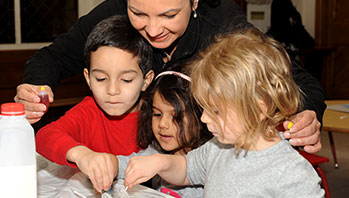- chart paper
- color circles
- glue
- paint squares (solid: blue, brown, green, orange, purple, yellow) (shades: blue, brown, green, orange, purple, yellow) (can be found at paint supply stores)
- category
- color
- dark
- group
- light
- shade
MA Standards:
Speaking and Listening/SL.PK.MA.1: Participate in collaborative conversations with diverse partners during daily routines and play.
Language/L.PK.MA.6: Use words and phrases acquired through conversations, listening to books read aloud, activities, and play.
Language/L.PK.MA.5.a: Demonstrate understanding of concepts by sorting common objects into categories (e.g., sort objects by color, shape, or texture).
MA Draft STE Standards:
Physical Sciences: Matter and Its Interactions: Structure and Properties of Matter/PS1.A: Describe, compare, sort and classify objects based on observable physical characteristics, uses, and whether it is manufactured as part of their classroom play and investigations of the natural and human-made world.
Head Start Outcomes:
Language Development/Receptive Language: Attends to language during conversations, songs, stories, or other learning experiences.
Language Development/Expressive Language: Uses language to express ideas and needs.
Language Development/Expressive Language: Uses increasingly complex and varied vocabulary.
PreK Learning Guidelines:
English Language Arts/Language 2: Participate actively in discussions, listen to the ideas of others, and ask and answer relevant questions.
Mathematics/Patterns and Relations 7: Explore and describe a wide variety of concrete objects by their attributes.
Small Group: Color Categories

© Commonwealth of Massachusetts, Department of Early Education and Care (Jennifer Waddell photographer). All rights reserved.
STEM Key Concepts: There are many different colors; A color can have many different shades (from very light to very dark)
ELA Focus Skills: Concepts of Print, Listening and Speaking, Vocabulary
Educator Prep: Prepare color circles by writing the color names on each circle (blue, brown, green, orange, purple, red, yellow). If possible write the color names in corresponding crayon or marker color.
Arrange and tape the solid paint squares in a row on the floor: blue, brown, green, orange, purple, red, yellow.
- Then place the shades of paint squares in pile on the floor and ask children to help you group them, or make piles of each color.
- Explain that when you group something you choose one thing that is the same or different about the objects, such as color. Say, Let's put the squares in color groups or categories under each color in the row.
Encourage children to describe the color groups. It is likely children will disagree in which category some colors belong. (may be a mix of green and blue, red and orange, etc.) Guide discussion as children sort the colors into categories by offering support such as,
- Josh thinks this color square is a shade of orange and belongs in the “Orange” group, but Lisa thinks it is a shade of red and belongs in the “Red” group. Both answers are correct, so how can we decide where to put the color square?
- Why do you think this color belongs in this group? What shade of red is it? Encourage children to use vocabulary words such as dark and light. Allow children to use made up words such as bluey-purpley to describe colors. Ask, Do you think it could also belong in another group? Why do you think that?
Take It Further: Once children have finished sorting the color squares, have them graph the results. Glue the color circles in a column running down the left side of the graph. Say, This chart is like the one we made of our favorite colors. This type of chart is called a graph. We can use a graph to help us see which colors have the most or least shades.
Adaptation: For children with high-level math skills, ask them to count the squares in each row, then present simple math problems, For example, say, The orange row has 2 squares. How many more squares does the green row have?
Adaptation: For very young children, you may prefer to use only two or three categories of colors.
